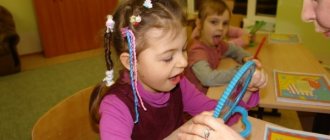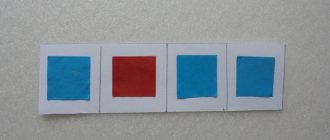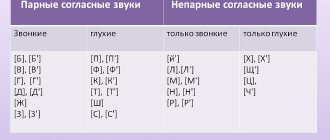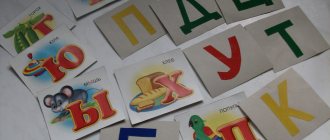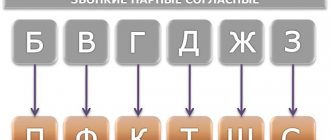- Hard and soft consonants
- Voiced and voiceless consonants
- Hissing and whistling consonants
- Letter and sound Y
The Russian language has 21 consonants and 37 consonant sounds:
| Letter | Sounds | Letter | Sounds | |
| B | [b], [b'] | P | [p], [p'] | |
| IN | [in], [in'] | R | [р], [р'] | |
| G | [g], [g'] | WITH | [s], [s'] | |
| D | [d], [d'] | T | [t], [t'] | |
| AND | [zh], [zh'] | F | [f], [f'] | |
| Z | [z], [z'] | X | [x], [x'] | |
| Y | [th'] | C | [ts] | |
| TO | [k], [k'] | H | [h'] | |
| L | [l], [l'] | Sh | [w] | |
| M | [mm'] | SCH | [sch'] | |
| N | [n], [n'] |
Consonant sounds are hard and soft, voiced and voiceless. The softness of sound in transcription is indicated by [' ].
Hard and soft consonants
A hard consonant sound is obtained if after the consonant there is a vowel A, O, U, Y
or
E
:
na, lo, ku, we, fe
.
A soft consonant sound is obtained if after the consonant there is a vowel E, E, I, Yu
or
me
:
be, le, ki, nu, la
.
The softness of consonant sounds is also indicated using a soft sign - b
. The soft sign itself does not indicate sound. It is written after a consonant and together with it denotes one soft consonant sound:
lynx
[lynx'],
fire
[ogon'],
blizzard
[v'y'uga].
Most consonant letters correspond to two sounds: hard and soft, such consonants are called paired
.
Paired consonants for hardness - softness:
| Letter | Sound | Example | |
| Solid | Soft | ||
| B | [b] | [b'] | ba – bi |
| IN | [V] | [V'] | va – vi |
| G | [G] | [G'] | ga – gi |
| D | [d] | [d'] | yes - di |
| Z | [h] | [z'] | for – z |
| TO | [To] | [To'] | ka-ki |
| L | [l] | [l'] | la-li |
| M | [m] | [m'] | ma – mi |
| N | [n] | [n'] | on - neither |
| P | [P] | [P'] | pa – pi |
| R | [R] | [R'] | ra – ri |
| WITH | [With] | [With'] | sa – si |
| T | [T] | [T'] | ta-ti |
| F | [f] | [f'] | fa–fi |
| X | [X] | [X'] | ha-hee |
But there are consonant letters that correspond to only one of the sounds: hard or soft. Such consonants are called unpaired
.
Unpaired hard consonants (always hard):
AND
[zh],
Sh
[sh],
C
[ts].
Unpaired soft consonants (always soft):
H
[h'],
Sh
[h'],
J
[th'].
In the Russian language there is a long, voiced soft sound [zh']. It is found in a small number of words and is obtained only when pronouncing combinations of the letters zhzh, zzh, zhd
:
reins, rattle, rain.
Article:
Whistling sound defects are especially common in children. Sigmatisms (distorted pronunciation of whistling sounds) and parasigmatisms (replacement of whistling sounds with others: hissing, front-lingual, etc.) greatly spoil a child’s speech. Sigmatisms can be: - labial-dental sigmatism: whistling [s], [s'] are replaced by sounds close to [f], [f']: “fabaka” (dog), “funka” (sledge), “finium” "(blue), "pheno" (hay); sounds [z], [z'] - to sounds reminiscent of [v], [v']: “vayka” (bunny), “vuby” (teeth), “vebra” (zebra), “veleny” (green) ; — interdental sigmatism: the tip of the tongue is placed between the teeth, causing words with whistling sounds to acquire a “lisp” sound; - lateral sigmatism: the lateral edge of the tongue or the tip of the tongue, when pronouncing whistling sounds, appears between the molars on the right or left, the tongue “falls” to the side, hence the name; — nasal sigmatism: occurs with open rhinolalia (split of the hard and soft palate) and rhinophonia (paresis, paralysis of the soft palate), when air flows into the nasal cavity when pronouncing sounds. Parasigmatisms can be: - dental parasigmatism: replacement of sounds [s] - [s'] respectively with [t] - [t']: “tanki” (sledge), “tom” (catfish), “teno” (hay) , "tiny" (blue); replacing the sounds [z] - [z'] with [d] - [d']: “dvuk” (sound), “oak” (tooth), “Dina” (Zina), “dileny” (green); - hissing parasigmatism: the sounds [s] - [s'] are replaced by the sounds [sh] or [sch]: “shanki”, “shanki” (sledges), “shushki”, “shushki” (drying); sounds [z] - [z'] to sounds [zh] or [zh']: “zhuby”, “zhyuby” (teeth), “zhima” (winter), “zhaika”, “zhaika” (bunny). - softening defects (replacement by hardness - softness): this is when hard sounds [s] - [z] are pronounced respectively, as paired [s'] - [z']: “syup” (soup), “syanki” (sledge) , “sin” (son), “zyayka” (bunny), “zyuby” (teeth), “kozi” (goats). Or vice versa: “son” (blue), “seno” (hay), “Soma” (Syoma), “zyma” (winter), “zyleny” (green); - substitutions for deafness - voicedness: the sound [z] is replaced by the sound [s], the sound [z'] - by the sound [s'] and vice versa: “suba” (teeth), “sima” (winter), “zanki” (sledge ), "zeno" (hay). Such disturbances in sound pronunciation can lead not only to dyslalia (impaired sound pronunciation), but also to dyslexia (reading impairment) and dysgraphia (writing impairment). HOW TO PRONECT WHISTLING SOUNDS CORRECTLY: [S], [S'], [Z], [Z'] For whistling sounds, the shape of the tongue and its position in the oral cavity are very important. Normally, on [С], [Сь, [З], [Зь], the wide tongue with its tip rests against the base of the lower front teeth. In this case, the lateral edges of the tongue are pressed against the upper molars. It turns out to be a mound with a hollow in the middle. Some children (especially those who were close friends with the pacifier!) have a flat tongue, with a weakly defined hollow. But it is the groove that directs the stream of exhaled air during whistling sounds in the right direction: strictly in the middle of the tongue. There is no well-defined groove - and a trickle of air spreads out in all directions. In addition, the child’s tongue sometimes cannot rest its tip against the base of the lower incisors: it keeps slipping. The child doesn’t even feel it: for some reason, sensitivity in the tip of the tongue is lost. STAGE OF SOUND PRODUCTION Sound production is the process when articulation is formed, the child learns to pronounce sounds and isolated sound. The stage of sound production is characterized by the formation of the skill of correct pronunciation of sound in isolation, consolidation of the auditory, kinesthetic image of sound, and the use of visual perception of articulation. At this stage, the speech therapist should build his work in these areas: develop speech perception, form phonemic analysis, develop articulatory motor skills, and work directly on sound production. At the preparatory stage, speech perception should be developed using tasks for simulating syllables. Syllables that contain consonant clusters (pronounced correctly by the child) are provided. It is necessary to develop phonemic perception, analysis and synthesis, this will allow one to develop the ability to isolate the desired sound in a word, find its place, and separate it from other sounds, especially from those that are distant in articulation and acoustics. Considering the level of mastery of the phonemic side of speech, one should work on difficult forms of phonemic analysis: determine the place of sound in words, draw graphic diagrams of words and mark the place of sound on it. It should not be forgotten that at the stage of sound production, children carry out phonemic analysis only based on the auditory perception of the word, without pronouncing it. At the stage of sound production, great attention should be paid to how speech motor skills develop (the kinetic and kinesthetic basis of articulatory movements). It is necessary to consolidate speech breathing skills, develop voice, and articulatory movements. Articulatory motor skills should be developed in the form of articulatory gymnastics. Articulatory gymnastics includes a set of exercises for the lips and tongue, which prepare for the correct pronunciation of sounds. Articulatory gymnastics is carried out in order to work out each element of the articulatory structure. Articulatory gymnastics should be carried out, imitating a speech therapist, sitting in front of a mirror. If a child is unable to perform the exercises, then mechanical assistance should be used. Next, from passive execution of movements, you should move on to active actions. During the stage of sound production, the same rules are applied to articulatory exercises as at the preparatory stage. Movements of the organs of articulation must be accurate, smooth, without accompanying movements, performed with normal muscle tone, without excessive tension and lethargy. You should pay attention to a sufficient range of movements, the ability to hold the position of the articulatory organs for a certain time, and the switchability of movements. After the isolated elements are worked out, the movements are combined and included in a single articulatory structure. IT IS USED TO HIGHLIGHT SEVERAL WAYS OF PRODUCING SOUND: 1. By imitation - based on the auditory image, on the visual perception of articulation. This must be taken into account due to the fact that imitation develops very well in children. But by imitation, most often you can create a sound only when it is missing. · Invite the baby to smile broadly, leaving a small space between the teeth, place the tongue on the lower teeth, and try to pronounce the song of flowing water: “S-s-s-s.” 2. With the mechanical method of installation, auxiliary means are used (spatula, probes, etc.). Mechanically, the articulatory organs are given a certain position. For example, when a child pronounces the sound [C], the speech therapist places a probe or spatula under the tongue and slightly lifts it towards the upper alveoli, producing a hissing sound. With this setting option, the child himself does not search; his articulation organs only obey the actions of the speech therapist. After long training, the child, without the help of a speech therapist, takes the necessary position, helping himself with a spatula or finger. 3. Staging using other sounds that are pronounced correctly, without the help of probes and spatulas. For example, to produce the sound [C], you can use the sound [I]. You should pronounce the sound [I], bite the side edges of the tongue with your molars, and blow on the back of the tongue so that the breeze “walks” along the tongue. · Take a light plastic ball and build a gate. Sit down at table. Let the baby smile, place the tip of his tongue on his lower lip and, pronouncing the letter “F”, try to score the ball. Make sure your baby doesn't bite his lip or puff out his cheeks. The sound should come out in the center of the tongue. 4. Staging sound from the articulatory structure. For example, the sound [Ш] should be placed from the “cup” articulation exercise. You need to invite the child to do the “Cup” articulation exercise outside the oral cavity, remove it inside the mouth and blow on the tongue. 5. Mixed method of staging, all of the above methods are used. INITIAL STAGE OF PRODUCING WHISTLING SOUNDS [S], [S'], [Z], [Z'] WITH INTERDENTAL SYGMATISM AND DENTAL PARASIGMATISM Start working on whistling sounds with the sound [S]. Try, sitting with your child in front of a mirror, to “construct” a “peacock” in your mouth (exercise “Mountain Hill”). It’s good if you succeed, but if not, you’ll have to call on articulation gymnastics and all kinds of fairy tales for help (articulation exercises, “Fairy tale stories from the life of Tongue” are presented on our website). It's time to remember the gnome Tongue. This time he will play the role of a climber. (Exercise “Climber”: the tip of the tongue “clings” to the lower incisors, the back of the tongue arches). So, the lower teeth are a rock ledge on which you must stay on at all costs! After all, it’s scary to think what will happen if a climber loses support under his feet! (An adult counts how many seconds the “climber” can stay on the ledge: the longer, the better). Of course, you will have to control the accuracy of your movements using a mirror. The child will try very hard: the gnome Tongue must not fall off the cliff! To prevent the tip of the child’s tongue from sticking out behind the teeth (in case of interdental sigmatism), teach the child to squeeze them together by telling a story called “A Brook” (Articulation exercise “A Brook”). “Once upon a time there was a stream. Very restless and talkative. He brought down a whole waterfall of sounds. Only, here’s the problem, the sounds weren’t quite right, they were kind of lisping and splashed in all directions. No one could understand what the stream was talking about. To make the stream's voice clear, a dam had to be built. Clench your teeth. Like this. Amazing! Smile. The stream was left with a small crack between the front teeth, and it began to flow down in a cold, even stream.” Say “S________” for a long time, demonstrating to the child the correct articulation of the sound [s]. Let the baby place his hand under his chin and make sure that the stream of air is cold and narrow. Now ask your child to organize his own “stream”. This will not happen right away. The most important thing is that the tongue does not stick out between the teeth and does not interfere with the pronunciation of the sound [C]. If this time nothing succeeds, a match (without the head of sulfur) and the continuation of the story about the talkative brook will help. “One day the passage of the stream was blocked by a log. (Place a match with one end between the baby’s incisors and ask to hold it in this position. The tongue is at the bottom of the oral cavity and does not protrude!). The stream had to try very hard to remove the obstacle!” And now the child must forcefully pronounce the sound [C], directing a stream of air directly at the match. It should fly out like a cork from a bottle. The exercise is done under the strictest supervision of adults, God forbid if a match ends up in the baby’s respiratory tract! Another exercise that will help cope with interdental sigmatism. It's fabulous and very funny. It's time to remember with your child about the gnome's friend Tongue - Kitten. He loves to play with reels. Knowing this, the tongue itself often turns into a funny reel. Exercise "Reel". Take the mirror again. The tip of the tongue, as in previous exercises (“Gorochka”, “Climber”, “Stream”), is pressed against the lower incisors from the inside. The middle part of the tongue curves sharply and becomes wide, with a hollow in the middle. The “coil” tongue either rolls forward or moves back. And so - several times. The most important thing is that the tip of the tongue is securely attached to the teeth. These four exercises (“Mountain”, “Climber”, “Rivek”, “Coil”) must be performed for at least a month. The muscles of the tongue should become stronger, and movements should gain precision and confidence. They will help get rid of interdental sigmatism. PRODUCTION OF WHISTLING SOUNDS [С], [С'], [З], [З'] WITH LABIODENTAL SYGMATISM What if the child’s problem is not in the tongue, but in the lower lip, which strives to connect with the upper teeth during whistling sounds? And then “dog” turns into “fabaka”, “soup” into “foop”, “bunny” into “vaika”, “fence” into “vabor”. In this case, as you remember, they talk about labiodental sigmatism. But you can deal with it too. One has only to call the lower lip to obedience. Take a mirror, demonstrate a Hollywood smile and, holding the baby’s lower lip with your finger, ask the child with an equally dazzling smile to pronounce the sounds [С______], [С'______] for a long time. Happened? Now remove the prop and have your child repeat the sounds again. Is there something wrong? You'll have to repeat it all over again... Over and over again until it works. If this does not help, you need to teach the child for some time to voluntarily lower his lower lip. He should be able to control it easily! Perform the same articulation exercises (“Gorochka”, “Climber”, “Stream”, “Coil”) as when fighting interdental sigmatism (see above). Finally everything is ok. To reinforce the correct pronunciation, use the syllables: S___A, S___I, S___Y, S___E, S___U, S___I, S___E, S___E, (Whistling sounds [S], [S'] are pronounced for a long time!) Here the lower lip can again play against the rules! It's okay, you'll have to hold it for a while longer. TECHNIQUES FOR CORRECTIONAL WORK FOR INTERDENTAL SYSMATISM OF WHISTLING SOUNDS [S], [S'], [Z], [Z'] Set of exercises: “Smile”, “Shovel”, “Coil”, “Brushing teeth”, “Swing”, “ Delicious jam." Correction of interdental sigmatism. A). The child is asked to perform the “Coil” exercise; when the child learns to perform this exercise well, it is suggested that the “Coil” be removed into the back of the mouth, but the tip of the tongue should be kept in place - behind the lower teeth. The speech therapist places a match in the middle of the tongue and asks to blow quietly so that the air stream passes through the middle of the tongue. Then the match is removed. The sound /S/ is pronounced. If the defect still persists, it is recommended to pronounce syllables for a while, then words with a match in the middle of the tongue or with closed teeth. b). If the child does not hold the tongue behind the lower teeth, the speech therapist holds it in the following way: we place a bent match into the mouth, one end of which is located towards the roots of the lower teeth, and the other is held by the speech therapist. We ask the child to reach the edge of the match with the tip of his tongue and in this position pronounce the sound /S/. V). If it is not possible to teach the child to hold the tongue behind the lower incisors for a long time, we teach the child to pronounce the sound /S/ with closed teeth. Correction of hissing sigmatism. First, the child is asked to distinguish between the correct and incorrect sounds of the sound /S/ (whistle - hiss). The differences between correct and defective articulation are then shown in front of a mirror. Additionally, kinesthetic sensations are used, depicting articulation with the hands. Having achieved correct articulation, exhalation is activated, giving the opportunity to feel the cold stream of exhaled air. You can temporarily use interdental articulation of the sound /S/. In the future, it is necessary to switch to normal dental pronunciation with clenched teeth, as is done when correcting interdental sigmatism (option c). Correction of lateral sigmatism. I believe that this is one of the most persistent defects, and without massage in the mouth and physical treatment, it is difficult to achieve a positive result. After a course of massage, the speech therapist (speech pathologist) can begin to perform those exercises that the child did not succeed in (for example, “Fipe”, “Cup”, etc.), that is, we achieve the formation of a “groove” along the midline of the tongue. The sound /T/ is used as a base. The sound /T/ is pronounced with some aspiration. The presence of aspiration is controlled by feeling a stream of air on the hand. At the next stage of work, the child is asked to lower the tip of the tongue behind the lower incisors. The teeth are clenched and a sound close to /Ts/ is pronounced, in which the sounds /T/ and /S/ are heard. Gradually, during the exercises, the sound /S/ is lengthened and then separated. After which the child is explained that this is the correctly pronounced sound /S/. Setting the sound /S/ from the sound /I/. This is the method I use most often. The child is asked to perform the “Smile” exercise, then open his mouth slightly and pronounce the sound /I/. At this time, we draw his attention to the position of the tongue (lies in the oral cavity, the tip is behind the lower incisors). We ask the child to pronounce /I/ several times, then, holding the tongue in the same position, pronounce /S/. If, when pronouncing [S] - [S'] and [Z] - [Z'], some kind of squelching is heard, we can confidently talk about lateral sigmatism. Now the problem lies both in the tongue itself and in the direction of the air stream. With lateral sigmatism, it does not go in the middle of the tongue, but slides either to the left or to the right, and maybe in both directions... Such deviations from the course are easy to detect if you put your palms on the child’s cheeks. Very often, lateral sigmatism indicates serious disorders: paralysis or paresis in the muscles of the tongue. Eliminating this defect is not so easy. You will probably need massage and articulation gymnastics (exercises “Mountain Hill”, “Climber”, “River”, “Coil”, etc.). The most important thing is to strengthen the side edges of the tongue, make them rise, and direct the air stream in the middle of the tongue. It's unlikely to succeed the first time. Start the work of correction with... punishment. No, not a child, but a tongue. Tell your child that the gnome Tongue is not distinguished by exemplary behavior. And therefore, he also has to be punished, spanking with his lips: “five-five-five-...” (Exercise “Let’s punish a naughty tongue”). The wide, relaxed tongue should be between the lips, not moving or moving to the side! Oddly enough, the child will do this exercise with great pleasure! After educational work, the tongue will probably become obedient. It's time to use the reward and play something interesting with him, for example, football. Make impromptu gates on the table of two cubes, put a cotton ball in front of the child, and let the gnome clog the tongue into the gates of the goals (“Exercise“ Fuck the goal in the goal ”). The more goals, the better. Make sure that the tongue when performing the exercise lies spaced on the lower lip, and the cheeks in no case are swollen! Do not forget to remind the child that the game is funny, so the sponges should smile. And now it's time to read with the child this: a soccer ball. In the courtyard, the football ball rushed all day. He played with us, but he did not see a bitch. He ran at him: with _______________. We feel sorry for him! (E.G. Karelskaya) with what sound the ball was blown away, the child should show: “With _________”. The ball was sealed, and now it needs to be pumped up. Show how a gnome tongue, using a pump, pumps the ball. True, without the help of a child, he is unlikely to cope! The child demonstrates the operation of the pump, and at the same time trains in the correct pronunciation of the sound [s] (exercise “pump”). The articulation should be clear: the sponges smile, the tip of the tongue is reliably fixed behind the lower incisors, the air is extinguished abruptly: c-ss ... the tongue should be absolutely symmetrical (not to move sideways!). Doing all this, the child will learn to direct the stream of air in the middle of the tongue. What to do if the child pronounces the sounds [s] and [h] softly, or replaces them with hissing (hissing parasygmatism)? Apparently, the child has a hypertonicity in the muscles of the tongue, the tip of the tongue does not rest against the lower teeth, but pulls back, deep into the mouth, the tongue is excessively raised. Hypertonus is removed using relaxing massage and articulation exercises (“pancake”, “we will punish the naughty tongue”, “Fuck a goal in the gate”). Then the production of whistling sounds goes the same as with interdental sigmatism (the third section of this article). Automation of sounds [s] [s'] a) in isolated pronunciation: following the advice of the previous sections, you and the child have already stopped the automation of isolated sound [s]. Now the child will perform a “song of water” (the sound will pronounce for a long time [with _____]), listening to such a poem. (You read the lines, the child pronounces the sound [s]): drip-sisters in the sea splashes a wave. Do you hear how she sings? "WITH_______________". This song of water of the drops, friendly sisters, sing in silence to the wind, fish and the moon. “With _______” - they rustle with sand, a pebble at the bottom of the sea. “With ________” - they are crushed about a rock, “with _________” - they flow down the glass. “With ________” - and hid in the shell. We will attach it to the ear ... And you will hear again you are the noise of the surf, the splash of the wave: "With _____________". (E.G. Karelskaya) (we hope that you have not forgotten that the baby’s tongue on the sound [C__] should not stick out between the teeth, move to the side?) B) in syllables, words and clean -speaking when the sound [___] will turn out perfectly, it will turn out. Fasten the success on the material of syllables, words, purely speakers and phrases: Sa-s-s-S-SO-SO SU-SO SU-SY-SE-SE-SO-SU-SY-SAS-SAS-SAS AS OS-OS-OS US-US-SSS-SS ES-ES IS-IS-ES SA: Sami, Sad, Salad, Sanya, Boot, Saika, Samovar, Aircraft, Sayrah, Sachka, Salo, Salom. Saber with: som, dream, soda, juice, salt, sonya, owl, sor, hundred, hundred, honeycomb, solo, juicy, variety SU: soup, bag, bitches, knot, court, Saturday. Surok, pike perch, drying, knot, bag, essence of Sy: son, cheese, cheese, fed, heart, sung, son, cheese, etc. As: us, pineapple, kvass, brass, hour, class, palace, karabas drum, atlas OS: nose, boss, question, vote, colossus, space, hair, request, mowing, demand of uses: mousse, minus , bus, crocus, focus, bite, vinegar, plus, flux IS: rice, miss, cypress, Narcissa, Paris, Boris Sa-Sa-Sa: Fox runs in the forest. A wasp in the garden flies in the garden. Bright braid. SO-SO-SOS: The fox has a wheel. In the movie Sophie Marso. Su-Su-Su: We are not afraid of a fox. Snow goes in the forest. Father to a braid sharpened. Sy-Sy-Syu: Fluffy tail at the fox. Bad Sonya without a braid. Sa-s-s, sa-s-s,-on the table we have a wasp. Sy-Sy-Syu, Sy-Sy-Sy-We are not afraid of a wasp. Su-Su, Su-Su-Su-we will not drive us. AS-AS-AS: Sonya has pineapple. We go to class today. We have a free hour. OS-Os-OS: Dog Blue your nose. Hall has a question. Senya in the canopy of the hay. Us-US: this is a thread of beads. Put a plus sign. From the wasp - a bite. IS-IS: in a bowl, weld Fig. Boris entered the class. Narcissus blooms in the garden. Si-ss-sse-seo-seo-sie-sie-si-si-si-si-si-si-si-si-si-si-si-and-yu-yu-sisy-and-yo-si-SIS-SIS-SIS-SIS-SIS-SIS-SIS-SIS-SIS-SIS-SIS-SIS-SIS-SIM-SIM : hay, Seva, Sergey, Semyon, North, Gray, Selo, Semafor, herring: Symga, Syoma, Funny Si-Si: hay in the hay of carry. Bring Sima to Sim. Invite sowing to visit. Seo-se-s: sing a song to Lisa. Blue bow on a spit. There are knitting needles on the wheel. Se-s-s: We will give an Osa syrup. Everyone went to the forest today! Wo-Sue-See: We told Vasya everything. Su-Syu-Syu: We were scainted with might and main. The hay was given to Karasy. Continue in the same spirit, choosing new words with sounds [s] and [s']. c) in tongue twisters at the canopy and Sani Som with a mustache. Forty -forty eaten a piece of cheese. In the garden of Dusi duck and geese. Sanya and Kostya go to Sona. Sanya with a bride month dough. Sanya mows hay, and Sonya wears hay. Senya in a dream sits on a pine tree. A neighbor - a homebody has a neighbor - a fidget. In a bowl, pussy has delicious sausages. They frightened Lucy's bugs of the geese. Frosi has pineapple and apricots with a tray. Sonya and Stas ate pineapple. Vlas at Glory ate lard, and Nazar licked the cream. The neighbor's homebody has a fidget neighbor. Senka is carrying Sanka and Sonya on a sled. d) in riddles if together is all seven I, it turns out ... (family). The third day is fragrant in the Persian garden ... (Lilac). This green bird loves the fat ... (tit). A mustachioed beetle crawled to the cutter, asked him to hide ... (frock coat). Invites all the guys to taste the crop ... (Garden). A lot of OS flew, take care, baby, your ... (nose). He is not afraid of heat. He is the favorite of the children, this is good -natured and smart and the lop -eared ... (elephant). She does not sleep at night, she looks very vigilantly in the distance. It was like a pumpkin that is predatory ... (owl). (Riddles of E.G. Karelskaya) Work on the sounds [h] [s '] sounds [h], [z] can have the same defect as the sounds [s], [s']. You need to work on them in the same way. The only difference is that [h], [z] - voiced (when they are pronounced there is a voice, voice ligaments work). If the child stunes these sounds (pronounces them without a voice), you need to tell a fairy tale about the voice that lives in the neck. The child puts his hand on the throat (his own or adult) and listens to the story. On the sounds of [s] [s '] the voice “sleeps” and the sled of his house does not tremble, and on the sounds of [z] [z'] his voice wakes up and begins to sing and the walls of his house tremble, vibrate. Demonstrate this clearly, pronouncing at first the deaf and then voiced whistling sounds. Then proceed to consolidate the sounds [h] [s '] in the same sequence as sounds [s] [s']. The only thing that we must remember is that the sounds [h] [s '] at the end of the words stun and turn into sounds [s] [s'] Ze-Ze-Ze Za-Zo-Zo-Ze-ZE for: Hall, Factory, Hare, Bunny, Fence, Outpost, Dawn, Credit, why, patch, corral, task Zoya, Zosia, Zosim, Call, Zori, Zori , Zorka, goiter, zombie, vigilant, keen, gold: tooth, teeth, zummer, bison, having worked out syllables and words, take sentences, pure spokes and poems abounding with sounds [z], [z]. For-and-out, for------us, a goat is chasing Zina. Zu-Zu-Zu, Zu-Zu-Zu, place a goat into the pen. PS-SZA, ss-zza, bell at the goat. Ze-Ze-Ze, Ze-Ze-Sza, Hay we will give a goat. Zoe and Zina Buzina in the basket. Buba's bibs got their teeth. Zosya called a bunny to visit. Nazar goes to the bazaar, buy a goat Nazar. Zoya Zaikina is a mistress, only a bunny is a hitch. In the zoo monkey, snakes, bison and pheasants. Zoe has a mimosa, and Zina Rose. The bell rang loudly, he calls Zoya to the lesson. The rose will freeze from the frost. Zina in the store forgot the basket. In the store bought Zina a basket.
Voiced and voiceless consonants
Consonant sounds can be divided into voiceless
and
voiced
.
Voiceless consonants are sounds that are not produced using the voice. They consist only of noise. For example, sounds: [s], [sh], [h'].
Voiced consonants are sounds that use the voice in their pronunciation, that is, they consist of voice and noise. For example, sounds: [р], [ж], [д].
Some sounds are paired: voiced - voiceless, such sounds are called paired
.
Paired consonants according to deafness - voicedness:
| Voiced | B | IN | G | D | AND | Z |
| Deaf | P | F | TO | T | Sh | WITH |
Unpaired voiced consonants:
J, L, M, N, R.
Unpaired voiceless consonants:
X, C, Ch, Shch.
School classification
The first classification criterion is: hardness/softness. 18 out of 21 consonants have pairs of hardness and softness, that is, in different words they can be pronounced hard or soft. For example: cow, friend - k, r, v, d, g in these words - solid. However, we can choose other words where they will be soft: rivers, see, whoop - here we already pronounce them softly.
There is no hardness/softness pair for six sounds: w/sh/ts (hard only) and h/y/shch – (soft only). Whatever vowel is after z/sh/ts, they will be solid: life - [zhyz'n'], compass - [tsy'rkul'], sew - [shyt']. Ch/y/sh – always pronounced softly – practice: bangs, brush, iodine, fir-tree [yo'lka], tickle, tea, etc.
On a note. There may be deviations from this rule when it comes to borrowed words. For example, in the word “jury” [zh'] is pronounced softly.
The second criterion is sonority and deafness. Compare the pronunciation of [z] and [s], [d] and [t], [b] and [p], [g] and [k] - what is the difference? In the first case you add a voice to the pronunciation, in the second there is no voice, only noise.
There is no voiced/voiceless pair for sonorant sounds. There are five of them: [p], [l], [m], [n], [th]. They are only voiced. To make it easier to remember sonorants, say them several times in the sequence given above. They are pronounced easily, without hesitation, and remain in memory.
Voiceless unpaired: [x], [ts], [h], [sch]. They cannot have a voiced analogue; in principle, they do not exist.
We looked at the signs that are included in phonetic analysis at school. I’ll take the word “cranberry” as an example so that all the signs are better remembered in your head.
- Emphasis: cran'kva.
- Syllables: klu-kva.
- Characteristic:
- K – [k] – consonant, hard (paired), voiceless (paired).
- L – [l'] – consonant, soft (paired), voiced (unpaired), sonorant.
- Yu - [u] - vowel, stressed.
- K – [k] – consonant, hard (paired), voiceless (paired).
- В – [в] – consonant, hard (paired), voiced (paired).
- A – [a] – vowel, unstressed.
- 6 letters, 6 sounds.
Have questions? Write in the comments, I will answer within 24 hours.
Hissing and whistling consonants
The sounds [zh], [w], [h'], [sh'] are called hissing consonant sounds . The sounds [zh] and [sh] are unpaired solids
hissing consonants:
iron
[zhel'ezo],
six
[shest'];
but in combinations zhi, shi
s
is not written .
The combinations zhi, shi
are always written with the letter
and
:
live
here, gara
zhi
,
shi
lo, karanda
shi
.
The sounds [h'] and [h'] are unpaired soft
hissing consonants:
watch
[ch'asy],
pike
[sh'uka],
but in combinations cha, sha
the letter
a
, and in combinations
chu, schu
the letter
y
:
cha
shka
,
square
,
stocking
,
pike
. The sounds [z], [z'], [s], [s'], [ts] are called whistling consonants .
Correction
To eliminate articulation defects, gymnastics, breathing exercises, and logorhythmics are used. The type of violation must be taken into account. It takes more time to correct dental and lateral sigmatism than to normalize phonation in interdental and nasal sigmatism.
Articulation gymnastics
The following articulation exercises are recommended:
- Fence
We make a wide smile, teeth are visible. We fix the position of the lips for a few seconds. Then we repeat the exercise 2-3 times.
- Mustache
The child holds flat, light objects (strips of paper, tubes, pen) with his lips.
- Inflating the balloons
The cheeks are involved. The child inflates and deflates his cheeks alternately.
- Rent a pencil
The kid blows on a pencil that lies on the table.
- Imitation of chewing
- Singing syllables and sounds.
Massage
- Spot
We vibrate with our fingers under the chin, under the tragus of the ears. Open and close your mouth alternately during the massage.
- Soft palate massage
We knead the palate with our fingers until we get a pharyngeal effect.
Exercises
Tongue strengthening exercises:
- Pancakes
Licking the mouth in wide, circular movements.
- Rain
Rhythmic slaps of the tongue on the lips.
- Biting the tip, back, sides of the tongue.
Tongue spreading exercises:
- Baking pies
Mechanical assistance to the tongue will be needed. Take the tongue with two fingers and fold it into a pie.
- Sleds
- Railway
Staging sounds
During speech therapy classes on sound production [C], the imitation method, working with a mirror, and the mechanical method are used.
